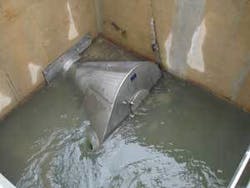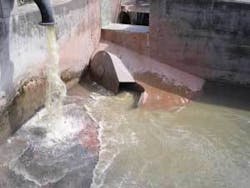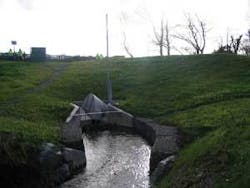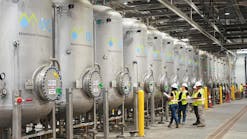A rising trend in American stormwater management, devices have been a mainstay in Europe.
Burgeoning commercial and industrial development is putting increased pressure on drainage systems. Land and vegetation act as a natural filtration system during storms. Conversion of open space to impervious materials such as roads, buildings, and parking lots increases the volume of runoff and risk of downstream flooding. Worse, too fast an influx of water into the drain overtaxes combined sewage systems, causing untreated sewage to spill out into waterways.
Until recently, most U.S. developers and municipalities relied on end-of-pipe solutions such as large detention tanks, deep tunnel storage systems, and high rate treatment facilities to combat urban flooding problems. These large, structurally intensive systems, however, are extremely costly to purchase and maintain.
To alleviate these challenges, many are now looking to an alternative approach long relied on in Europe and the United Kingdom. Over 16,000 vortex flow controls, also known as vortex “valves”, are installed around the world to manage water flow in stormwater storage schemes, stormwater sewers, combined sewers and wastewater treatment plants. These novel devices are useful for several types of applications.
Inlet Control
Vortex valves are highly effective for controlling the rate of water flow that enters a drainage system. The conventional approach to dealing with large storm events was to increase conveyance capacity in order to remove the water as fast as possible. Traditional drainage systems have a basic opening that water flows through, with no means to adjust the intake flow of water. Alternatively, a vortex valve optimizes the amount of flow.
Designed with a snail or conical shape, the valve can choke back the flow of water as needed. The attenuated flow can be temporarily stored in underground tanks or in surface ponds for slow release into the sewer system. This ensures the rate of inflow won’t exceed hydraulic capacity of the system. Matching system inputs to hydraulic capacity can reduce flooding, backup and overflow frequencies.
The city of Evanston, Illinois, USA, near Chicago has deployed 2,831 Reg-U-Flo vortex valves to date for inlet control. Like many communities around the Great Lakes, Evanston is served by a combined sewer system. During rainstorms, stormwater is discharged to a deep tunnel system. Conveyance capacity of the local sewer was limited, though, and residents in certain areas experienced basement backups up to six times a year. A traditional relief sewer system would have cost an estimated $290 million and caused major disruption to up to 90% of the city’s streets.
Instead, the city hired engineers who thought up a better alternative involving a partial sewer separator with an above-ground storage and overland flow. The firm installed inlet flow restrictors in the catch basins to limit inflow to the hydraulic capacity of the existing system. Excess storm flow is temporarily retained on the street surface and overland flow routes are established to convey flow to new high capacity inlets at the head of new stormwater relief sewers. This was all done at approximately 50% of the cost of a conventional relief sewer system, and resulted in protection against basement backup.
David Crain, president of Ley & Associates Inc., has worked on the project to implement vortex valves in Evanston since the 1980s and sees the unique benefits of this method of stormwater management. “(Evanston’s) system allows them to do over-land routing of the water into the deep tunnel system, which is different than a typical town would have,” he said. “That was one advantage of their system in Evanston.”
Another unique feature Crain cited that helps with the handling of Evanston’s stormwater: “In most cases you’re using the valve to back up water, in effect, street ponding the excess water that the sewer can’t handle. Then, as the storm subsides, obviously the flow goes back through this pipe,” said Crain. “What they’ve done (in Evanston) is that the elevation changes in the gutter system along the street also allows some water to go to the additional sewer system that’s directly connected to the deep tunnel, so they can get rid of excess water that way as well.”
The plan is to eventually convert the entire city of Evanston over to Vortex Valves for stormwater management.
Stormwater Storage Systems
Another interesting application for vortex valves is in meeting water quality volume detention and maximum discharge standards at stormwater storage facilities. In most states, developers must ensure post-development stormwater flow doesn’t exceed the pre-development flow or that the first flush of runoff is detained onsite for a predetermined period of time. This often requires the creation of enormous storage tanks to contain water for even the largest storms. But much of this storage space is left unused, unless there’s an intense storm.
Alternatively, a vortex valve passes more flow during smaller storms and throttles the flow back during larger storms. This allows municipalities to utilize a storage system up to 40% smaller than with a traditional system, resulting in considerable cost savings.
Site engineers for the new Chevy Chase Bank development in Darnestown, Maryland, USA, found this an attractive approach. Using a traditional orifice opening, the engineers would have been required to design and install a 100-by-54-foot storage tank. When they sized the storage system using a vortex valve, they were able to reduce the storage tank footprint by 42%, resulting in a savings of $150,000 in capital outlay alone.
Maintenance costs are also much lower. With a traditional orifice system, the opening itself isn’t very large and thus is more prone to blockage from trash and other debris that gets washed into the drain opening during storms. A vortex valve can provide an opening up to 600 times larger while still maintaining the correct discharge rate, making it less likely to become obstructed.
These storage tanks also must be cleaned out periodically using vactor trucks to clear out any extraneous silt buildup. The smaller the tank, the fewer trips needed to dispose of excess sediment. This significantly cuts down on mobilization costs for maintenance equipment.
Conclusion
Increased urbanization, combined with changing weather patterns, is causing uncontrolled stormwater runoff in many communities. This has prompted a new way of thinking among U.S. municipalities and developers, who are now adopting European methods for managing stormwater. These vortex valves have proven highly promising for improving the effectiveness and cost efficiency of stormwater management systems.
Author’s Note:
Overseeing research and development, Robert Y.G. Andoh is director of innovations for Hydro International, a Portland, Maine, USA-based company with offices in the United Kingdom and Ireland. He has over 25 years of experience in the water industry, writing and presenting technical papers related to urban flooding, collection systems and wastewater treatment internationally. Joining Hydro in 1992, he also has lectured widely on urban water management, and is a visiting lecturer at Liverpool John Moores University and a member of the technical advisory board for the University of New Hampshire Stormwater Center. Contact: +44 (0) 800 269371 or www.hydro-international.biz






